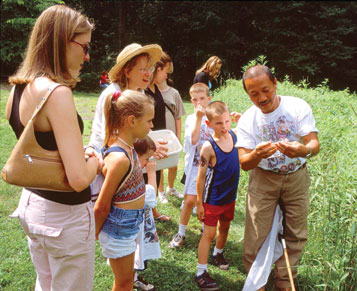Back
 Carnegie
Museum of Natural History scientist Chen Young (right)
leads a BioForay excursion. Carnegie
Museum of Natural History scientist Chen Young (right)
leads a BioForay excursion.
PHOTO: MINDY
MCNAUGHER
Once spring arrives in the sun-starved Northeast and nature’s
colors thankfully turn from brown to brilliant shades of
green, thoughts
of getting back to nature can overcome even the most ardent
couch potato. Still, the story of a teenager so inspired
by the wonders of nature that she happily wakes up at the
crack of dawn to go exploring in the thick, damp woods
sounds a bit like science fiction.
It’s a fact, not
fiction, says mom Patricia Hasbach, a Pittsburgh psychologist
who visited Powdermill Nature
Reserve with her daughter during last year’s annul
BioForay. In a review of their experience, Hasbach wrote: “I
knew the weekend was successful when I woke my teenage
daughter at 5:30 a.m. to go bird banding and she awoke
with a smile and said, ‘I was dreaming of science.’
“
We had a wonderful time,” Hasbach added. “The
professionals there were accessible, knowledgeable, and
enthusiastic.”
Carnegie Museum of Natural History’s
2,200-acre nature reserve and biological field station
in the Ligonier Valley
is a warm, welcoming place for scientists, environmentalists,
and amateur nature lovers all year round. But for five
days in June, it becomes particularly alive with fun and
exploration during the annual BioForay, now in its fourth
year.
Call it a scientific version of an outdoor scavenger
hunt: An area of about 75 acres is divided into a grid
of 50-meter
squares; then, teams of experts and amateur naturalists
methodically identify all the organisms found within each
square and record their precise locations. They identify
birds by their songs; they catch snakes and mammals in
safe live traps and release them after recording their
vital stats; they gather insects, spiders, and snails for
accurate species identification at the Museum of Natural
History in Oakland; and they identify the eclectic plantlife.
It’s
serious science: Powdermill scientists are using the information
from each BioForay to build an impressive
database that will become an important tool for studying
and preserving the environment well into the future. But
in Powdermill’s warm and welcoming way, serious science
can and should be open to everyone. And it is. At each
BioForay, amateurs are invited to sign up to work alongside
field scientists as they survey and document the land and
its treasures. The cost is minimal, and the experience
is priceless.
The last day of the BioForay is the “public
day”—or,
perhaps more fitting, family day. Powdermill field scientists
and educators, Museum of Natural History scientists, and
guest scientists from across the country set up shop under
tents to share their work with visitors. Powdermill also
organizes kids activities throughout the day—all
free to the public.
“
It’s a wonderful day,” says Theresa Gay Rohall,
education coordinator for Powdermill. “The scientists
are so generous with their time. And there’s no such
thing as a dumb question; they’re here to interact
with everyone.”
Rohall says that just under 300 acres
of Powdermill land will have been studied after this year’s BioForay— with
many more to go. That’s good news for amateur nature
sleuths who still want to get in on the action, and even
better news for
parents like Patricia Hasbach, who dare to dream that there’s
still a place where kids can be inspired by nothing more
than what the natural world has to offer.
Back
| Top |